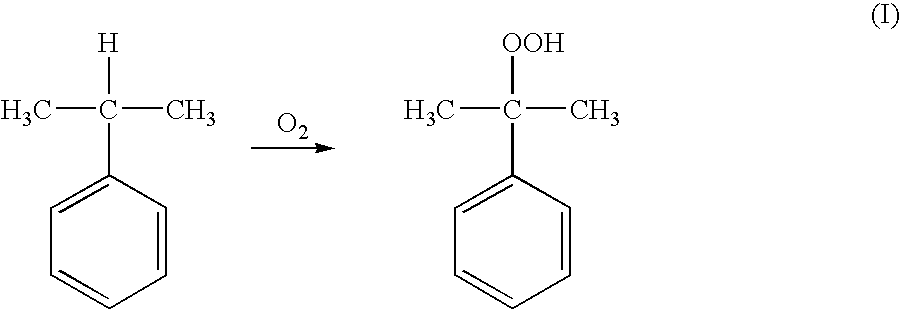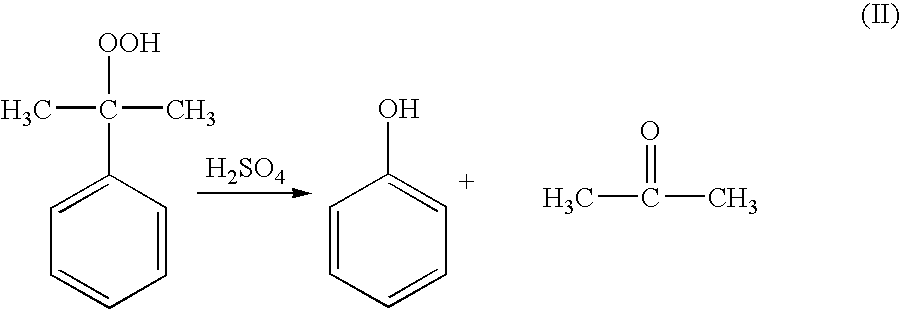Method of measuring the concentration of hydroperoxides of alkylaromatic hydrocarbons
- Summary
- Abstract
- Description
- Claims
- Application Information
AI Technical Summary
Benefits of technology
Problems solved by technology
Method used
Image
Examples
example 2
[0029] In this example, eight comparative samples were collected at 2 hour intervals from a CHP decomposition reaction vessel of an industrial system for producing phenol and acetone. These samples were delivered to the laboratory and analyzed for the residual concentration of CHP by the prior art method of iodometric titration as described in Example 1. However, a sodium carbonate solution was immediately added to the samples of CHP decomposition reaction mixture as soon as the samples were collected to neutralize the sulfuric acid, thereby stopping the cumene hydroperoxide decomposition reaction. Otherwise, the values of the residual CHP concentration that would be obtained would be too low.
[0030] Ten (10) milliliters (ml) of the previously neutralized sample of CHP decomposition reaction mixture were pipetted into a flask, to which 10 ml of acetic acid and 40 ml of a saturated potassium iodide solution in methanol were then added. The contents were refluxed for 5 minutes until th...
example 3
[0035] In this "in-process" example, two transmission probes made of stainless steel, which are analogous to those manufactured by Axiom Analytical Incorporated, were inserted into pipes (fluid conduits) in a continuously operating commercial phenol production facility using a multiple stage cumene oxidation system. The transmission probes were put into contact with a liquid reaction mixture exiting from the 1st and 4th oxidation reactors, and detected the presence of CHP. Periodically, the signal from the probes went to a standard NIR spectrometer, which performed a measurement and calculated the CHP concentration. Analyses were carried out using the spectral range of 6,600 to 8,000 cm.sup.-1. Measurements were carried every 5 to 6 minutes for 5 days, which gave approximately 250 measurements per day. This data, in turn, was transferred in digital form to a computer of a distributed control system produced by the Honeywell Company. The internal analytic data collected during in-pro...
example 4
[0038] In this "in-process" example, a transmission probe made of stainless steel, which is analogous to those manufactured by Axiom Analytical Incorporated, was placed in a pipe in a continuously operating CHP decomposition system. The probe had a continuous stream of the CHP decomposition reaction mixture passing through it. In this commercial plant stream, which consisted basically of phenol and acetone, the CHP concentration was measured at a frequency of once every 2 to 3 minutes. The spectrum was scanned, the obtained signal was processed, and the CHP concentration was calculated. The spectral range that was used was 6,000 to 10,000 cm.sup.-1. Approximately 400 measurements were performed per day, and the tests were carried out over a period of 3 days, i.e., 72 hours.
[0039] The analysis data were transferred in digital form to a computer of a distributed process control system, which used the data as an input signal for control. Table 4 presents the data obtained over the 3-da...
PUM
| Property | Measurement | Unit |
|---|---|---|
| Length | aaaaa | aaaaa |
| Length | aaaaa | aaaaa |
| Wavelength | aaaaa | aaaaa |
Abstract
Description
Claims
Application Information
 Login to View More
Login to View More - R&D
- Intellectual Property
- Life Sciences
- Materials
- Tech Scout
- Unparalleled Data Quality
- Higher Quality Content
- 60% Fewer Hallucinations
Browse by: Latest US Patents, China's latest patents, Technical Efficacy Thesaurus, Application Domain, Technology Topic, Popular Technical Reports.
© 2025 PatSnap. All rights reserved.Legal|Privacy policy|Modern Slavery Act Transparency Statement|Sitemap|About US| Contact US: help@patsnap.com


